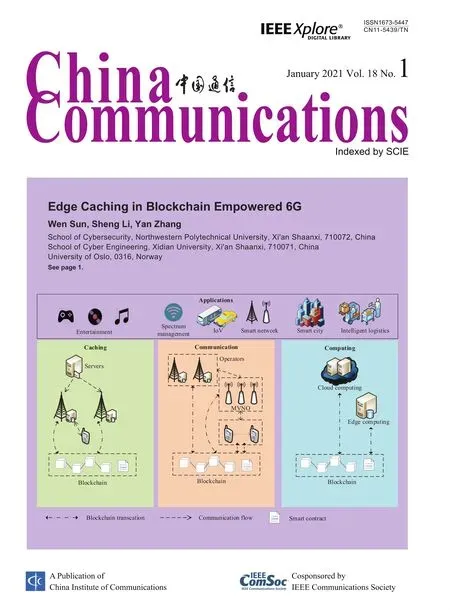Layered D2D NOMA
Jinjuan Ju,Jinyuan Gu,Guan Zhang*
1 School of Information Science and Technology,Nantong University,Nantong 226019,China
2 School of Electronic and Information Engineering,Nantong Vocational University,Nantong 226007,China
Abstract:This paper investigates a layered power allocation (PA) non-orthogonal multiple access(NOMA) scheme for device-to-device (D2D) relaying networks,where the strategy of partial data transmission at relay nodes are adopted to improve the efficiency of resources.In addition,to satisfy different quality-of-service (QoS) requirements from multiple users,layered and grouped manners are involved.Moreover,the closed-form expressions in terms of the sum-rate (SR) and outage probability of the proposed scheme are derived for independent Rayleigh fading channels,which demonstrates our theoretical analysis.Both analytical and simulation results are provided to show the superiority of our proposed scheme compared with existing works.
Keywords:non-orthogonal multiple access;deviceto-device;sum-rate;outage probability
I.INTRODUCTION
With the increasing massive connectivity of beyond 5G and 6G networks,varied new technologies have been investigated,a promising candidate of multiple access scheme named non-orthogonal multiple access(NOMA) has been received a lot of attentions [1-3].In contrast to conventional orthogonal multiple access(OMA),NOMA achieves a higher spectrum efficiency,and accommodated more users by employing a power domain at transmitters.To balance users'fairness,more power will be allocated to the users with weak channel resulting in a system performance limitation[4].
As one of the most attractive properties of NOMA,cooperative relaying scheme has been introduced to NOMA systems[5-7]with different issues and channel state information (CSI) assumptions,as well as different channel models [8,9],such as Rician fading and Nakagami-m fading channels.Compared to conventional NOMA,the key advantages of cooperative NOMA are that this scheme is capable of achieving low system redundancy,better fairness,and higher diversity gain.To enable more efficient access of multi-user that originally out of the transmission range,device-to-device (D2D) aided cooperative relaying communication has been a new endeavor.By introducing D2D to NOMA,the higher spectrum efficiency and larger-scale system capacity can potentially be achieved[10-12].Nonetheless,the power allocation (PA) especially in multi-user scenario is difficult and complex.Although the exhaustive search method and advanced algorithm can solve the problem,both of them require a high amount of computation to obtain the optimal solution,which increases the system complexity.Trying to build an efficient and low-complexity PA scheme is our pursuit.As an effective utilization of resource technique,relay selection is possible to reduce the system complexity,as well as to improve the outage probability[13,14].However,for multiple users in regions with different quality-ofservice(QoS)requirements,the previous transmission schemes can be further improved.Two layers transmission is considered.PA is performed according to the total QoS requirements of users' in different regions during the first layer.In the meanwhile,during the second layer it is ordered by channel quality of users'in the same area.In this former,it is derived by QoS requirements reversely;and then it can be given by channel quality directly.In addition,“relay nodes”can be selected in regions for second layered transmission,respectively.To the best of our knowledge,the application of layered NOMA with D2D aided cooperative communication has not received much attention.Note that this notion of layered D2D is primarily inspired by simplifying PA for multi-user NOMA system to further reduce its outage probability.
Based on above observations,in this paper,a new layered D2D aided NOMA (L-D2D-NOMA) system is studied.Compared to the previous decode-andforward schemes[15-17],the proposed layered transmission scheme is addressed to optimize the efficiency of resource by layered forwarding the decoded signals during the cooperative phases,and improve the system outage probability performance through multiuser grouping transmission.To satisfy the groups'different QoS requirements,meanwhile minimize the inner-group users' outage probability possibly,the layered D2D aided cooperative relaying manner is adopted.The key contributions of this paper are summarized as follows:
·A new multi-user layered scheme is investigated in cooperative NOMA system,where users are grouped based on their prejudged quality of service (QoS) requirements,and then ordered according to their channel conditions within a group,i.e.,QoS requirements and channel conditions are employed between and within groups,respectively.In order to improve the performance and the efficiency of the multi-user system,unlike the conventional scheme,a two-layer NOMA transmission scheme is proposed.
·For further reducing inter-group energy consumption,as well as enhancing target inner-group signal forwarding,a PD-T strategy is involved,in which the selected nearest user (as a relay node) partially decoding the received superposition signals and forwarding the reconstructed new NOMA signal.Two layers with NOMA transmission are formulated to decide on the power allocations among the users:one for minimizing the outage probability at the inter-group “relay nodes”,and another for maximizing the sum rate at the inner-group users.By this way,either the“relay nodes”or the inner-group users can process the useful signals respectively,which will greatly improve the resource efficiency.
·The performance of the proposed scheme in terms of the ergodic SR and outage probability is analysed.Considering independent Rayleigh fading channels,the closed-form expressions of the ergodic SR and outage probability are derived.Simulations support that the derived closed-form expressions of our proposed PD-T for multi-user layered-NOMA scheme outperforms the previous cooperative NOMA scheme significantly.
The rest of this paper is organized as follows.In Section II,we present the research problem and the proposed model.The performance in terms of the ergodic SR and outage probability are analyzed in Section III.Section IV contains the system simulation conditions and results.Finally,the paper is concluded in Section V.
II.SYSTEM MODEL AND PROPOSED SCHEME
In this section,we firstly introduce our proposed system model based on the idea of layered transmission after multi-user grouping,and then analyze the feasibility of the D2D scheme in the relay cooperative phase.Consider a downlink scenario with one BS,two inter-group “relay nodes”,as well asiandj(i >j) inner-group multi-user11,where all nodes are operated in a half-duplex mode.Each node is equipped with a single antenna.The BS and “relay nodes” are constrained by the transmitted powersPtandPr,respectively.Denote the channels from the BS to “relay node” and “relay node” to user ashSDmandhDmUn,where (m=1,n ∈{1,···,i})and (m=2,n ∈{1,···,j}) represent groups 1 and 2,respectively.Further assume that all channels experience independent and identically Rayleigh fading with variancesλSRiandλRiDjas their average powers.Moreover,it is also considered that there is no direct link between the BS and users since the users are out of the transmission range from BS.Moreover,each“relay node”is assumed to know the CSI ofhSDmandhDmUnperfectly.
2.1 Layered NOMA Scheme
Unlike conventional NOMA,in the proposed multiuser cooperative transmission networks,two layers NOMA transmission is involved,where users are grouped based on their prejudged QoS requirements.For more details,group 1 can be a cruise ship,where there are some users' demands for high-quality service,and the corresponding target data rate or threshold value will be high.On the other hand,group 2 can be regarded as a fishing vessel with relative low users and QoS requirements,and hence the target data rate will be much lower than that of the former.Therefore,according to the number of innergroup users or the threshold values,two groups are formulated,where the inner-group user with the best reception ability is chosen as the“relay node”,such asD1orD2shown in Figure1.The first layer NOMA transmission is from the BS to“relay nodes”.During the first time slot,the BS transmits a superposed signal,whereis the signal for the groupm ∈{1,2},anda1/a2witha1+a2=1 denotes the power allocation coefficient.The power coefficients are related to target data rates.Without loss of generality,note thata1≥a2,since the QoS requirements of group 1 is higher than that of group 2.The observation at “relay node”m(1≤m ≤2)is given by
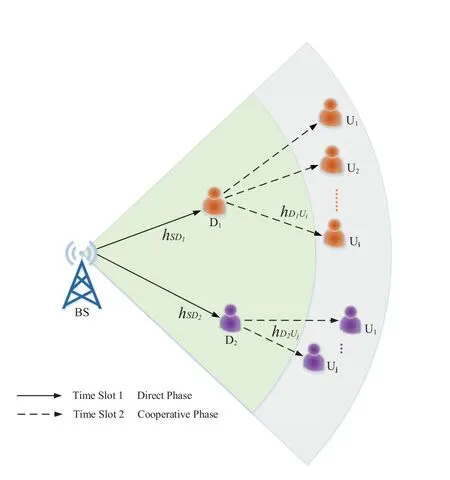
Figure1.The proposed layered-NOMA with D2D transmission scheme.

wherenDm ∼CN(0,σ2) is the additive white Gaussian noise(AWGN)during the 1-st NOMA transmission with mean 0 and varianceσ2.Following the NOMA decoding principle,the relay nodes will decodeAby treating signalBas noise,and employing SIC to acquire it.In this manner,the received signal-to-interference-plus-noise ratio (SINR)and signal-to-noise ratio(SNR)at relaymnode are given byanddenotes the transmit SNR.
The second layer NOMA transmission is determined by the“relay nodes”to inner-group users.During the second time slot,a D2D strategy,i.e.,the selected nearest user partially decoding the received superposition signalsyDmand forwarding the reconstructed new NOMA signalSDm,is involved at relaymnode.As mentioned above,the inner-group users are ordered based on their channel qualities,without loss of generality,assume thatThe use of NOMA impliesb1≥···≥biwithforD1andc1≥···≥cjwithforD2,wherebn/cndenotes the new PA coefficient.Therefore,the transmitted signals atD1andD2can be written aswherePrm=amPtdenotes the transmitted power ofDm.The received signal at the usernin groupmcan be written asyD1Ui=hD1UiSD1+nD1UiandyD2Uj=hD2UjSD2+nD2Uj,wherenDmUnis the AWGN with zero mean and varianceσ2during the 2-nd NOMA transmission.
To successfully achieve the signal reception and decoding,e.g.,in group 1,user 1 to useri-1 will decode the reception with SINR,while useriwill decode the received message with SNR since the last one is slightly different from the ones in front.Therefore,the corresponding effective SINRs forxk(1≤k ≤i-1)and SNR forxiare given as

and


and

2.2 PA Based on QoS Requirements and Channel Quality
As a strategy to improve resource efficiency,during the first layer transmission,only signalAin group 1 is decoded and forwarded to the users.Similarly,signalBis processed in group 2.It is easy to see that,not all the superposed signalSis forwarded to the innerusers,but only the one in target area is effectively operated.For the“relay nodes”,in this manner,only the signal decoded correctly will be forwarded,that is,the data rate which is greater than or equal to the target threshold value.Hence,the required SINRand SNRcan be written as

and

Since it is possible to improve the system performance,as well as reduce the energy consumption at“relay nodes”,the partial information transmission is regarded as a promising application prospect,especially in partial centralized D2D communication.According to the previously discussed PA criterion for this layer,parametersa1anda2can be derived from the prejudged data rate for each group reversely.Suppose that the rate corresponding to the QoS requirement of group 1 isR1bps/Hz,while the rate of group 2 isR2bps/Hz.With (6) and (7),according to shannon's theorem,two expressions can be obtained as
By simple calculation,the lower and upper bounds of parameters can be obtained.Hence,the range ofa1iswhich not only guarantees the QoS requirement of each group,but also meets the constraint condition of the “relay nodes”.Obviously,the correspondingly range ofa2is
Therefore,the following analysis and numerical simulation will be carried out in accordance with this PA criterion based on QoS requirements during the first layer NOMA.Especially in numerical analysis,the values ofa1anda2should meet the range requirements ofθ1andθ2.However,during the second layer NOMA transmission,as mentioned above,the innergroup users are ordered only based on their channel qualities.Hence,for parametersbnandcnduring this layer,only the sorting relationship of channel qualities requires to be satisfied.
In summary,a two layered NOMA transmission is involved,where two different power allocation schemes are employed.During the first layer NOMA transmission,the power allocation factors are determined by the prejudged QoS requirements of users in different groups;while,during the second layer NOMA transmission,these factors are depended on the channel qualities between the selected “relay nodes”and the inner-group users.
III.PERFORMANCE ANALYSIS
In this section,we will analyze the performance of our proposed L-D2D-NOMA scheme in terms of the ergodic SR and outage probability.
3.1 Ergodic SR Analysis
The achievable rates for signals can always be obtained according to shannon's theorem.With the analysis of the proposed model above,in general shown aswhereMis messageA/Bin group 1/2.For simplicity,denotingthen from(2),(3)and(6),(7),the expression related to rate of the previousk-th user in group 1 can be written as

while,for the last useriin the same group,the corresponding received SNRs can be written as
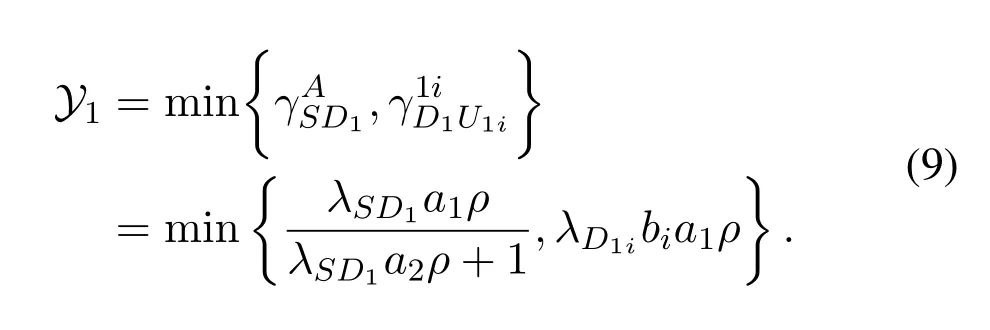
From (8) and (9),the achievable ergodic rates of all the users' within group 1 can be obtained by the use of complementary cumulative distribution function (CCDF),probability density function (PDF) and complex calculations.


Similarly,considering the rates of users in group 2,the correspondingX2andY2can be written as

and

Predictably,the closed-form expression will much convenient than the former one since there is a simplerY2.From (12) and (13),the achievable ergodic rates for userland userjin group 2 can also be obtained by employing the similar analysis method mentioned before.Therefore,the corresponding closedform expressions can be written as


3.2 Outage Probability Analysis
According to the QoS rates required by users,each user has a predetermined target data.When the link capacity cannot meet the required user rate,communication interruption will occur.In this section,we will analyze the solutions of the outage probability in our proposed system.Assume that for userkin group 1,the target rate isR1kand the predefined target rate threshold isRT1k,the outage probabilityO1can be described as
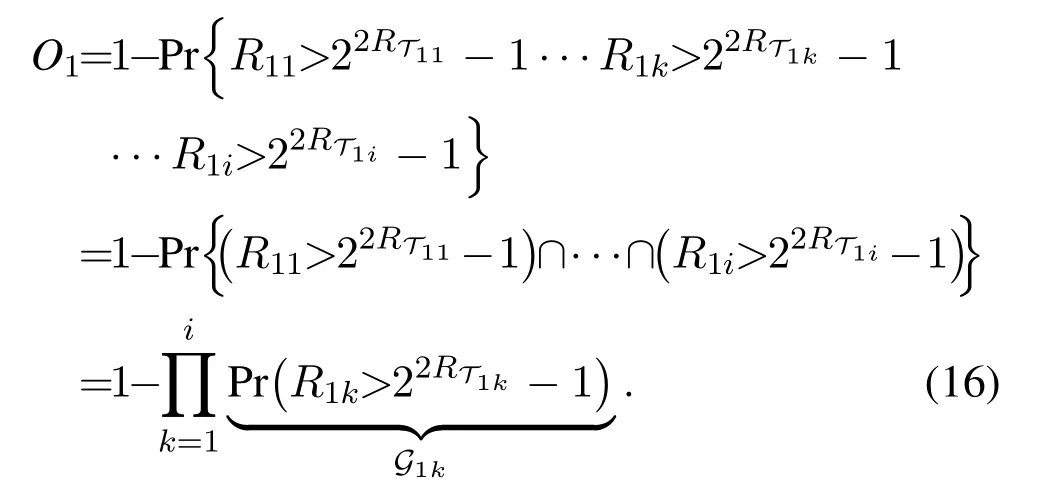
Further assume thatω1k=22RT1k-1 for simplicity and referring to the above analysis of ergodic SR,the exact expressions ofG1kcan be described as

With respect to userlin group 2,the outage probabilityO2can also be obtained by employing a similar analysis method,where the target rate isR2land the corresponding predefined threshold isRT2l,shown as Eq.(19).
IV.NUMERICAL RESULTS

Figure2.The ergodic SRs achieved by our proposed scheme with respect to transmit SNR.
In this section,computer simulation results are presented to demonstrate the performance of our proposed layered-NOMA scheme.For simplicity,the scenario of two users (i=2) in group 1 and one user(j=1)in group 2 is considered.All the numerical results are averaged over 120,000 channel realizations.The PA factors conform to the requirements of different schemes for the first and second layers NOMA of the system.In Figures 2 and 3,the ergodic rates of analytical results and the corresponding simulated ones match well.Also,the ergodic SRs versus power allocation factors for our proposed scheme with fixed transmit SNR are investigated,as seen in Figure4 for two-dimensional and Figure5 for three-dimensional.In addition,the outage performance of our proposed scheme is studied,as shown in Figure6 for group 1,i.e.,(O1)and Figure7 for group 2,i.e.,(O2)by comparing the results in three cases.Finally,Figure8 illustrates the improvement in system outage performance by comparing our proposed scheme with the previous NOMA scheme,reflecting the efficiency of resource optimization transmission.
4.1 Ergodic SR
Figure2 depicts the average rates of our proposed scheme with fixed channel parameters whena1=0.9,a2=1- a1,as well asb1=a1,b2=a2,andc1=1.Clearly,the simulation result either the rate of single signal or the SR of each group matches the corresponding analysis result perfectly.The rate of each user in group 1 is obviously greater than that in group 2,especially beforeρ=22 dB,which echoes the differences in QoS requirements among groups as described in Section II.Considering the performance in terms of ergodic SR,the value is respectively 4.101/2.048 bps/Hz for group 1/2 whereρ=22 dB.For simplicity,only the ergodic SR either for each group or for whole system is considered in Figure3,where the PA factors are modified,i.e.,a1=0.8 and the corresponding changes in other factors.Evidently,the graphic shows the same trend.However,the distribution of ergodic SRs among groups varies.With the decrease in the power ratiosa1andb1,the SR in group 1 for multi-user decrease while that in group 2 increase,and the gap between groups at a certain value of SNR becomes smaller.Meanwhile,a new demarcation point appears,namely,ρ=11 dB,before which the system SR of case 2 is greater than that of case 1,and after which the SR of case 1 is much greater.
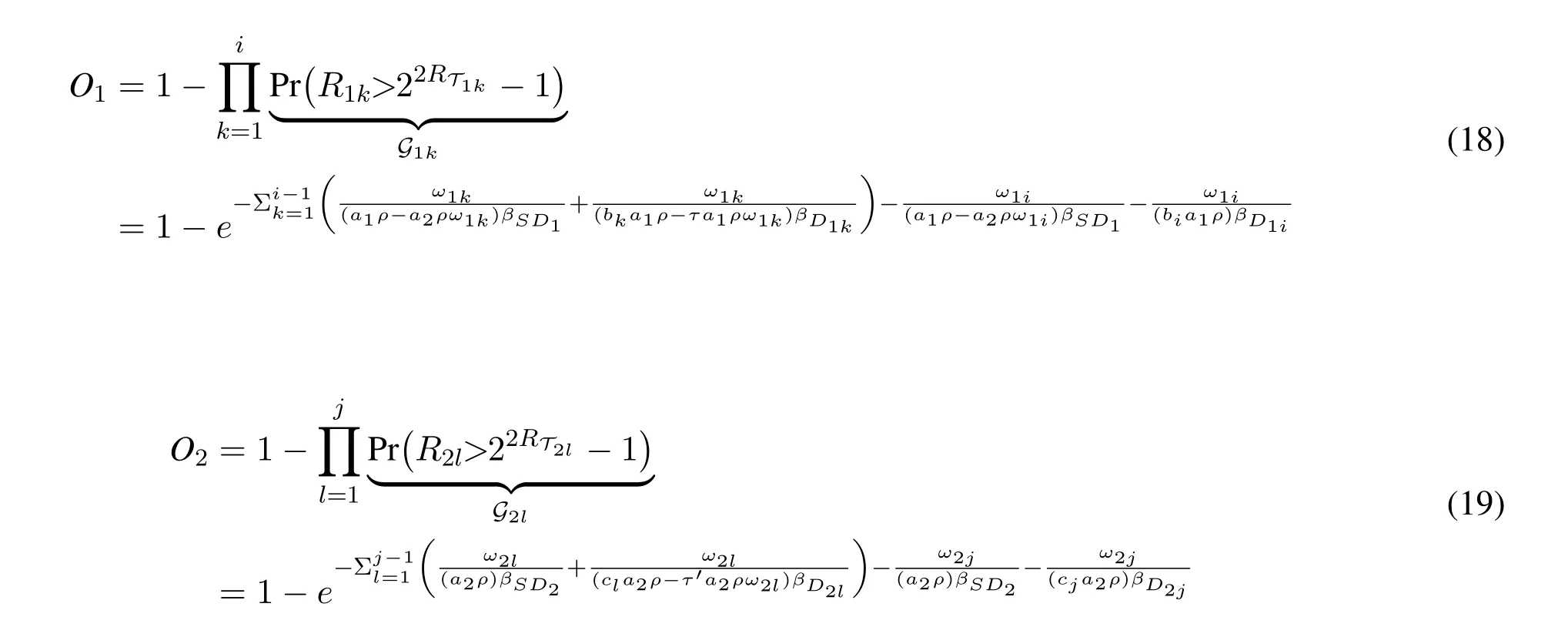
Figures 4 and 5 show the ergodic SR performance with respect to power allocation factorsa1andb1for our proposed scheme with fixed transmit SNR as comments in figures,respectively.As presented either in the two-dimensional or in the three-dimensional figures,optimal values ofa1andb1exist that maximize the ergodic SR.Obviously,the correspondinga1andb1for the optimal ergodic SR will be close to 1 as shown in the above two figures.Hence,the differences of PA factors and SNR have an effect on the average rates of inner-group users.Predictably,the advantage of our proposed scheme will become more pronounced with the increase of the performance difference between groups.

Figure3.The ergodic SRs achieved by our proposed scheme versus two cases of different PA factors.
4.2 Outage Probability
Figures 6 and 7 demonstrate the outage performance of our proposed scheme for groups 1 and 2 with three cases,where the PA factors area1=b1=0.9,a2=1-a1andb2=a2,as well asc1=1.The results show that the simulation values match the analysis ones well,and the performance improves as the channel gains increase and the threshold decreases.The former can be observed by comparing case 1 with case 2,while the latter can be shown by comparing case 2 with case 3;hence,case 2 has the best outage probability.Clearly,the outage performance of group 1 is better than that of group 2 since users in group 1 need higher QoS requirements.Considering case 2,to obtain the outage probability 0.1,the transmit SNR in group 1 is aboutρ=13 dB,and the value in group 2 is aroundρ=17 dB.The lower the outage probability is,the larger the gap of transmit SNRρbetween the two groups is.

Figure4.The ergodic SRs achieved by our proposed scheme versus different PA factor a1 for transmit SNR as ρ=15 dB.
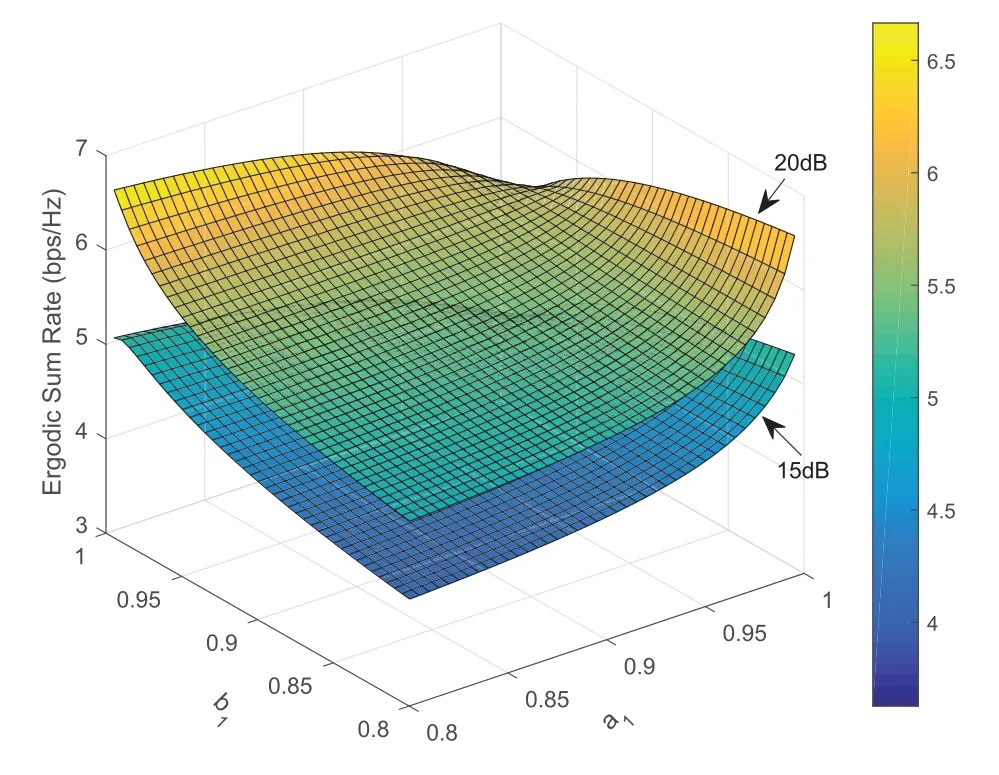
Figure5.The ergodic SRs versus different PA factors a1 and b1 for transmit SNR as ρ=15 and ρ=20 dB.
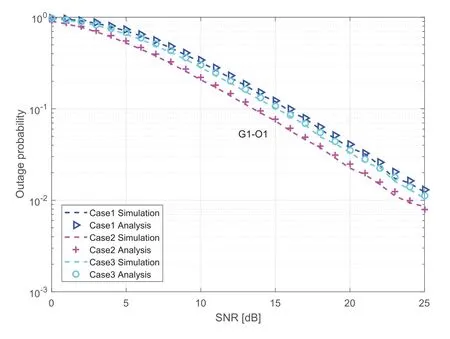
Figure6.The outage probability for group 1 in three cases.Case 1 versus the target rate as 0.6 with fixed λSD1=10,λD11=4 and λD12=6,as well as λSD2=6 and λD21=6.Case 2 versus the same target rate in case 1 with fixed λSD1=18,λD11=6 and λD12=10,as well as λSD2=10 and λD21=5.Case 3 versus the target rate as 0.75 with the same channel parameters in case 2.
In order to further show the advantages of our proposed scheme,Figure8 compares the outage probability performance for whole system between the proposed scheme and the previous conventional NOMA scheme in case 2 described in Figures 6 and 7,with respect to the transmit SNR.For the outage probability 0.1,the SNR in the proposed scheme is aboutρ=10 dB,while in the previous scheme is aroundρ=19 dB.It can be seen that the outage performance of our scheme has improved by 9 dB.The main reason is that,the proposed scheme can only show system outage when both groups are interrupted,while the previous scheme considers its outage as long as a partial interruption.In addition,the outage performance in previous scheme is obviously worse than that in each group,taking 0.01 as an example,the disadvantages are 6 dB and 3 dB comparing with the values in groups 1 and 2.Results reveal that,with a increasing transmit SNRρ,the proposed scheme leads to a better outage probability performance.This phenomenon is consistent with our research,hence the proposed scheme can offer a significant performance gain over the previous scenario,especially in terms of the outage probability.
V.CONCLUSION
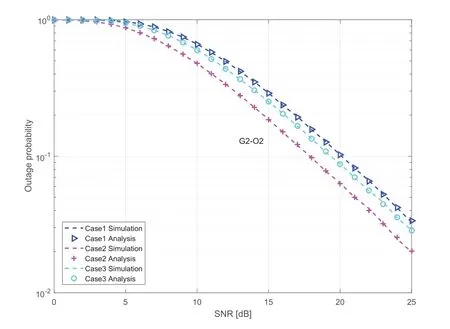
Figure7.The outage probability for group 2 in the above three cases as in Figure6 versus the transmit SNR.
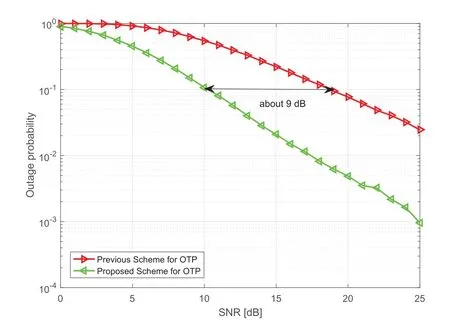
Figure8.Comparison of the outage probability for whole system between our proposed scheme and the previous NOMA scheme in case 2 in Figure6.
The paper investigated an effective layered transmission scheme for D2D-NOMA.In our proposed scheme,to further improve the efficiency of resources,the idea for the partial message transmission at the relay nodes has been proposed.In the meanwhile,two layers NOMA transmission is involved,where the multi-user are grouped based on their prejudged QoS requirements.The combination of layered NOMA transmission and D2D manner has been adopted,not only to satisfy the different QoS,but also reduce the outage probability.Without loss of generality,as long as users'distribution and QoS requirements are similar in space,such a structure of firstly grouping and then layering can be extended spatially,and the key issue is still the determination of PA scheme for each layer.It is desirable to analyze a two-layer transmission with corresponding PA schemes.Finding suitable criterion for grouping considering practical constraints,such as location and fairness,is one of the issues which will be studied in future work.In addition,the design of intelligent reflecting surface at relay nodes will be considered to study the performance of more practical cooperative NOMA.Moreover,the security mechanism and general channel models can be further investigated for transmission networks.
ACKNOWLEDGEMENT
This work was supported by National Natural Science Foundation of China(No.61971245,No.61801249)and Basic Scientific Research of Nantong Science and Technology Project(JC2019116).This work was supported in part by the Six Talent Peaks high level talent of Jiangsu Province(XYDXX-245).
NOTES
1Similar to the research in previous references[11,12,14],it is assumed that there is no transmission among relay nodes since that they are out of the service scope with each other.And the CSI is considered known at each receiving node perfectly.The scenario with interference and partial CSI may set aside for our future work.
- China Communications的其它文章
- Edge Caching in Blockchain Empowered 6G
- Spectrum Prediction Based on GAN and Deep Transfer Learning:A Cross-Band Data Augmentation Framework
- Fully Connected Feedforward Neural Networks Based CSI Feedback Algorithm
- Erasure-Correction-Enhanced Iterative Decoding for LDPC-RS Product Codes
- Power Allocation for NOMA in D2D Relay Communications
- A Game-Theoretic Perspective on Resource Management for Large-Scale UAV Communication Networks

